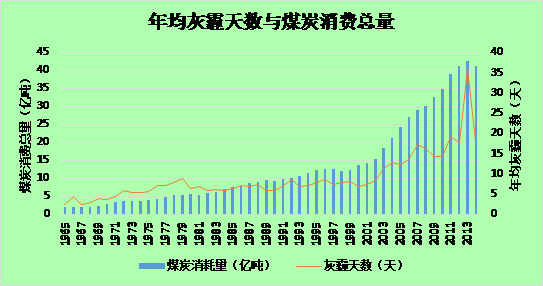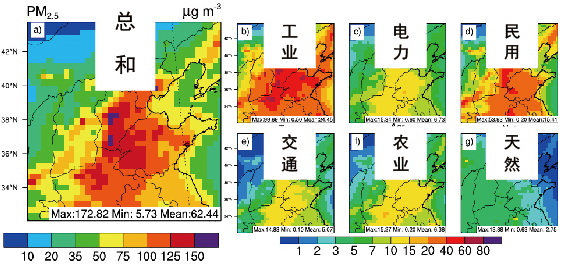作者:李雪玉、杨富强
2011年11月的一次大范围严重雾霾引起了公众的关注,让PM2.5迅速闯进了公众的视野。近三年来,雾霾在北方采暖季的“高烧不退”,尤其是2016年冬季橙色和红色预警接踵而来,让散煤一跃冲上了环境治理的风口。
PM2.5、雾霾、散煤,是于最近几年才兴起的名词,却以燎原之势点亮了中国区域大气质量的红灯。2015年,中国338个地级及以上城市首次有了全指标空气质量监测数据,从这些数据来看,全国约有80%的城市空气质量超标,其中最重要的超标因素就是PM2.5。从人口分布上来看,大概有85%的人口生活在不达标的城市里面。[1]
2016年的冬天,雾霾如期而至,国人再次经历了冬季的“呼吸之痛”。12月16日至22日,我国中东部出现大面积灰霾。据环保部通报,此次污染的灰霾面积为188万平方公里,其中,重霾面积为92万平方公里,占灰霾面积比例的49%。据绿色和平的计算,此次大气污染已影响了4.6亿人,污染程度是世界卫生组织(WHO)日常指标的六倍。
环保部监测数据显示,12月20日,全国空气质量日均值达到重度及以上污染的城市共有90个,京津冀及周边地区共54个,占总数的60%。其中,全国达到严重污染的城市共42个,京津冀及周边地区35个,占总数的83%。其中,石家庄市PM2.5日均值最高,达到614微克/立方米。截至12月21日15时,全国空气质量小时浓度达到重度及以上污染城市共50个,严重污染的城市共11个,其中京津冀及周边地区分别共占40个和10个。[2]
滚滚而来的雾霾究竟缘何而起?京津冀何以成为重灾区?攻坚多年的治霾之战,局势如何?在这场战役中,散煤治理作为最硬的一根骨头,又该如何啃下来?
1. PM2.5平均浓度、中国年均灰霾天数与煤炭消费量正相关
煤炭消费对中国经济高速发展的贡献有史为证,而其环境代价的难以承受之重是中国正在经历的当下。
从中国煤炭消费来看,煤炭在中国能源结构中占有非常重要的地位,从1980年至今的30余年内,煤炭占中国一次能源生产和消费量的比重一直在70%左右,远高于OECD国家20%左右的平均值。[3]进入本世纪后,随着中国社会经济的高速发展,煤炭使用量急剧增加,从2000年的14亿吨增长到2013年的42.44亿吨,13年间增长了约3倍,达到了煤炭消费的顶峰。
随着中国经济步入新常态以及能源结构调整,中国煤炭消费量于2014年出现下降,下降3.02%,耗煤41.16亿吨;2015年,煤炭消费继续走低,为39.63亿吨,下降3.7%。[4]根据测算,2016年前三季度全国煤炭消费约28.4亿吨,同比下降2.4%(减少6800万吨)[5],但8月份以来全国煤炭消费由负转正,其中11月份同比增长1.4%,截至11月,全国煤炭消费达34.9亿吨。[6]总体预测,2016年煤炭消费总量不会超过2015年,但三季度以来的煤炭消费增长使得2016全年煤炭消费的同比降幅大大减小。
煤炭消费的环境代价,以雾霾为代表的大气污染问题尤为严重。根据《中国气候公报》的统计数据,2003年以前,中国年均灰霾日数均低于常年值9天,但是2004年以来增长迅速,年均值达到12~20天,2013年,中国年均灰霾日数高达36天,创下52年之最。2014年,随着全国煤炭消费量下滑,全国平均灰霾天数也开始出现下降。根据《2014中国气候公报》,2014全年平均灰霾天数为17.9天。

图1中国历史煤炭消费量与年均灰霾天数
信息来源:《煤炭燃烧对大气污染排放的贡献》、《2014中国气候公报》、《2014能源统计年鉴》
如图1所示,2013年,既是中国煤炭消费的峰值年,也是中国年均日霾数最多的一年。同时,2013年也是中国执行环境空气质量新国标的第一年,既“PM2.5监测元年”。PM2.5浓度超标被认为是导致雾霾污染的重要原因。
根据《中国环境质量公报》的统计数据,2013年,74个第一批实施新空气质量标准城市的PM2.5达标率仅4%,年均浓度均值为72μg/m3,超过《环境空气质量标准(GB3095-2012)》限值要求1倍,是影响我国城市空气质量达标的最主要短板。2014年,74个城市的PM2.5平均浓度为64μg/m3,同比下降11.1%;2015年,为55μg/m3,比2014年下降14.1%。[9]截至12月底,2016年PM2.5平均浓度为49μg/m3,同比下降约11%[10]。整体来看,在过去的4年里,中国74个城市的PM2.5平均浓度逐年稳步下降。
图2 近三年中国煤炭消费量与PM2.5平均浓度变化图
信息来源:《中国能源统计年鉴》(2013-2015)、《中国环境质量公报》(2013-2015)
注:2016年PM2.5平均浓度为截至12月底的数据,来自中国环境报(2017.01.03);2016年煤炭消费量为估算值,按照同比下降率1.2%估算。
通过对中国煤炭消费量、全国平均日霾数以及中国74个第一批实施新空气质量标准城市的PM2.5平均浓度进行数据统计和分析,我们发现PM2.5浓度以及由此导致的雾霾污染,与中国的煤炭消费紧密相关。中国煤炭消费2013年达到峰值,全国平均日霾数也随之达到历史之最,2014年,中国煤炭消费呈现下降趋势,全国平均日霾数和中国74个第一批实施新空气质量标准城市的PM2.5平均浓度也随之下降。
2. 2016年三季度煤炭消费增长,冬季雾霾加重
自2013年12月中国经历重度雾霾污染之后,PM2.5年平均浓度和灰霾天数开始出现下降,空气质量总体呈现改善趋势。然而,进入2016年采暖期,雾霾加重的声音却不绝于耳。
从2016年雾霾发生过程来看,入冬以来,全国共发生了6次雾霾过程,其中12月16日至22日的雾霾最为严重,11个省市“沦陷”,多地PM2.5浓度爆表。截至12月21日15时,全国空气质量小时浓度达到重度及以上污染城市共50个,严重污染的城市共11个。其中,京津冀及周边地区共40个城市达到重度及以上污染,严重污染城市达到10个。[2]京津冀及周边地区再次成为重灾区。
从2016年的能源消费来看,由于一些高耗能行业产量的提升,全国煤炭消费量悄然走高。根据中国煤炭运销协会测算数据,截至2016年11月,全国煤炭消费约34.9亿吨,同比下降1.6%(减少5600万吨)。其中电力行业耗煤16.7亿吨,下降0.4%;钢铁行业耗煤5.7亿吨,下降0.6%;建材行业耗煤4.8亿吨,与去年同期基本持平;化工行业耗煤2.5亿吨,增长7.2%。[6]
而进入8月以来,全国煤炭消费开始由负转正,第三季度同比增长0.5%,其中电力行业耗煤增长4.8%,(9月份增长8.5%)。从目前数据来看,增长态势已持续到四季度,11月,全国煤炭消费同比增长1.4%,其中电力耗煤增长3.2%。[6]
考虑中国高耗能行业主要分布在北方,且北方冬季采暖煤耗需求释放,往往是雾霾的高发区。京津冀区域大气污染防治联合研究表明,京津冀区域国土面积虽然只占全国的2%,但2014年常住人口占全国的8%,煤炭消费占全国的9.2%,单位面积SO2、NOX、烟粉尘排放量分别是全国平均水平的3倍、4倍和5倍。此外,京津冀主要城市在冬季采暖期间的一次PM2.5增加50%左右。[13]从图3中也可以看出,京津冀及其周边地区在近4年中一直处于PM2.5浓度的高位区。

图3 中国74个第一批实施新空气质量标准城市的PM2.5年平均浓度分布图
信息来源:绿色和平发布的“2015年度中国366座城市PM2.5浓度排名”、“2016中国治霾故事,366座城市成绩喜忧参半”。
从环保部公布的74个城市PM2.5月均浓度变化来看,空气质量整体呈逐年改善之势。根据环保部空气质量公告,2013-2016年,74个城市PM2.5月均浓度逐年下降,年平均浓度依次为72μg/m³、64μg/m³、55μg/m³、49μg/m³。如图4所示,2016年前三季度,PM2.5月均浓度整体呈现同比下降趋势,8月份浓度水平开始升高,其中9月和11月的浓度水平比2015年同期水平略高。
从京津冀地区13个城市的PM2.5月均浓度变化曲线(图5)来看,自2013年以来,京津冀PM2.5月均浓度整体呈现下降趋势,2013-2016年均浓度依次为106μg/m³,97μg/m³,77μg/m³,71μg/m³。但进入2016年8月以来,PM2.5浓度出现明显地上升趋势,9-12月,PM2.5月均浓度反超2015年同期水平,11-12月,甚至超过了2013年同期水平,其中11月京津冀PM2.5平均浓度为102μg/m³,同比上升约9%。
图4 74个城市PM2.5月均浓度变化曲线
信息来源:环保部2013-2016空气质量月报;2016年12月浓度参考中国环境报(2017.01.03)
图5 京津冀13个城市PM2.5月均浓度变化曲线
信息来源:环保部2013-2016空气质量月报;2016年12月浓度参考中国环境报(2017.01.03)
3. 散煤无力独揽雾霾全责,“削峰压谷”监管为重
从图4 中国74个城市的PM2.5月均浓度变化曲线图中可以看出,PM2.5浓度在每年的10月至次年2月间浓度最高,这一时间段,恰是北方冬季供暖期,也是雾霾最严重的季节。
造成空气中PM2.5浓度增加的原因,既有气象条件影响,也有区域输入性影响,人为活动的影响更是不容忽视。根据清华大学环境学院贺克斌团队与亚洲清洁空气中心共同开发的《区域空气质量动态调控技术平台及典型应用案例》,工业过程和民用部门是京津冀地区一次PM2.5 的主要来源,分别贡献了54%和29%。其中工业过程排放主要来自于钢铁、水泥、炼焦等行业,民用部门排放主要来自于民用燃煤和生物质燃烧;此外,电力、供热、工业锅炉和交通部门分别贡献了4%、3%、6%和4%。[14]
根据清华大学对京津冀地区PM2.5的来源解析,PM2.5主要来自工业和民用两个部门,其中冬季由民用源主导,而其他季节则有工业源主导,且PM2.5平均浓度在冬季最高。

图6 京津冀PM2.5的来源解析图
信息来源:图片摘自“京津冀采暖季到来 冬季雾霾元凶:烧煤、没风”,财新网数字说频道
从PM2.5的来源分析来看,工业排放、机动车尾气污染、城市施工扬尘污染等属于基本负荷,其中,工业排放是主要来源。而冬季采暖期的燃煤污染是造成冬季PM2.5浓度剧增、雾霾严重的尖峰负荷。
冬季采暖期的燃煤,既包括燃煤电厂,也包括无减排措施或者减排水平较差的散烧煤。根据清华大学建筑节能研究中心的抽样调查,2014年我国农村生活用煤约为2亿吨。根据《中国能源统计年鉴》,2014年我国农业生产用煤2579万吨,城镇生活用煤1442万吨,住宿餐饮批发零售用煤3767万吨。根据工信部统计,我国工业燃煤锅炉年用煤7亿吨,其中20蒸吨以下燃煤锅炉耗煤量约2.8亿吨。总计我国散烧煤年用量至少达到5.6亿吨,这只统计了农村生活、农业生产、城镇生活、住宿餐饮、20蒸吨以下工业小锅炉等,如果再考虑公共机构、工业小窑炉以及其他尚未统计到或尚未识别的散烧煤,数值会更大。[15]
散煤燃烧基本上全部为分散式燃烧,没有采取除尘、脱硫等环保措施,据了解,1吨散煤燃烧排放的污染物量是火电燃煤排放的5~10倍,其对大气污染的贡献率高达50%左右。其中,民用煤炭约3亿多吨,尽管民用煤炭占比不足10%,但按目前情况推算,我国民用散煤污染物排放超过燃煤电站污染物排放总和。此外,由于散煤燃烧属于低矮面源,排放高度非常低,排出来很快就会被人体呼吸到,对人体健康的影响更为直接。因此,散煤燃烧对于污染物排放和人体健康危害的贡献更大且更直接。
由此来看,散煤无疑是雾霾治理的关键内容,然并非全部。京津冀区域正处在工业化和后工业化过程叠加的时期,燃煤、工业、机动车和居民生活排放量都处于高位。在PM2.5的构成中,除工业粉尘、机动车尾气颗粒物、道路扬尘、建筑施工扬尘、厨房烟气等一次来源外,人类活动排放的大量气态污染物如SO2、NOx、NH3、挥发性有机污染物(VOCs)等,都能在大气中被氧化产生硫酸盐、硝酸盐、铵盐和二次有机气溶胶(SOA),从而形成二次颗粒。有研究表明,全球范围内,二次源贡献率在20%—80%之间,在我国中东部地区常常高达60%,在成霾时往往二次颗粒物所占比例更高。[19]
从京津冀13个城市的N2O和SO2月均浓度变化曲线中可以看出,京津冀13个城市N2O和SO2的污染控制在2013-2015年间总体呈改善趋势。2016年,SO2月均浓度下降速度明显放缓,全年浓度水平接近2015年水平。而N2O污染物控制的改善趋势在2016年仅维持了2个月,进入3月以来,N2O浓度水平均高于2015年同期水平,甚至有赶超2014年的同期水平的势头。
图7 京津冀13个城市N2O月均浓度变化曲线
信息来源:2013-2016年空气质量月报,环保部。
图8 京津冀13个城市SO2月均浓度变化曲线
信息来源:2013-2016年空气质量月报,环保部。
2016年N2O和SO2的浓度升高并不仅仅发生在冬季,说明在京津冀地区PM2.5浓度和成霾过程的贡献中,除了冬季采暖散煤的尖峰负荷外,其它季节的污染物排放,即基础负荷也有重要贡献。
2016年下半年,国家发改委会同环保部在全国组织开展了环保电价专项检查。根据通告,检查中发现的主要问题是部分执行环保电价燃煤发电企业二氧化硫、氮氧化物、烟尘排放浓度小时均值超过规定的限值,环保设施不按规定投运,个别企业存在擅自改装软件设备,人为导致环保电价数据失真行为等。
根据环境保护部通报重污染天气督查情况,个别企业存在擅自生产、撕毁封条等行为,违反限停产规定。省界地区小企业集中,违法问题较为突出。
正所谓“霾去如抽丝”,大气污染非一日之功,雾霾治理需要针对具体污染源统筹考虑、各自施责。鉴于PM2.5来源及雾霾污染的季节性变化,雾霾治理应考虑全年控制“基本负荷”,即有效控制工业、交通、生物质、扬尘等排放,以降低污染物在全年的平均浓度,发挥“压谷“的效力。建议在“十三五”污染物总量控制规划中,增加NH3、VOCs和颗粒物等气态污染物指标,有效控制PM2.5的二次源排放。同时,针对以散煤为主的“尖峰负荷”,加大冬季治霾力度,以实现“削峰”。在加强各行业、各部门排放控制以及严格监管的基础上,提出散煤治理的具体规划。
4. 散煤治理的难点
12月21日下午,在中央财经领导小组第十四次会议中,习近平在谈到北方地区冬季清洁取暖时表示,推进北方地区冬季清洁取暖,关系北方地区广大群众温暖过冬,关系雾霾天能不能减少,是能源生产和消费革命、农村生活方式革命的重要内容。要按照企业为主、政府推动、居民可承受的方针,宜气则气,宜电则电,尽可能利用清洁能源,加快提高清洁供暖比重。
近几年政府针对散煤治理已采取一系列措施,且已取得一定成效。但散煤治理作为我国煤炭清洁高效利用领域的重点和难点,作为雾霾治理的关键,仍然存在底数不清,规划缺失,散煤替代成本高,关键技术不成熟,补贴政策不健全,市场环境待优化,监管成效难保障等若干问题。
首先,由于散煤尚未有明确定义,所以对其使用情况的统计也很难做到准确。对于农村和城镇的居民散烧煤的数据统计,有些省市已经开展入户调查,但与当地统计数据出入很大,很多民用煤,并未进入统计口径。目前,关于散煤使用总量的说法也各有不同,有说我国散烧煤为6-7亿吨(《中国能源报》2016年6月20日15版),也有说散烧煤为7-8亿吨(《中国能源报》2016年5月30日1版),甚至有专家认为,不止7-8亿吨[20]。
其次,散煤治理涉及政府部门10余家,任务包括能源结构调整、优质煤炭替代、煤炭质量监管、政策资金支持和价格政策等等。政府部门纷纷出台政策,并投入大量人力物力,且有些政策为多部门联发,但从整体上来讲,缺乏顶层设计和统一的、清晰的路线图,且存在职能分散,多龙治水,系统性、协调性比较差,基层监管人员不足,工作推进难度大等问题。
再次,技术规范和标准体系不健全。目前我国民用煤质量标准中,缺乏衡量污染物排放水平的重要指标——焦油含量指标。注重煤源本身质量,缺乏燃用排放标准。此外,现有民用炉具的相关国家标准,在规范产品市场方面发挥了一定作用。但随着国家节能环保标准的提高,部分内容已不能满足要求。在民用炉具污染物排放限定标准,居民燃煤排放和能效检测标准等方面存在空缺。
第四,民用型煤供应体系不完善,我国民用型煤生产布点较分散,不适应工业化、大规模生产和现代化物流配送要求。目前,从事洁净煤生产的多为小企业,快速投建的型煤厂普遍存在设计不合理、工艺落后、设备简陋、工作环境差、安全隐患多等问题,产品质量保障体系不健全。
第五,政府补贴难以持续。洁净型煤替代烟煤主要靠政府财政补贴,补贴标准是确保补贴后的洁净煤价格略低于市场烟煤价格。目前多地已采取此措施,其中北京、天津等地做的比较好,由于河北省补贴水平低于京津两地,出现河北商家抢供北京和天津的现象。在当前经济下行压力大的形势下,财政补贴在北京、天津地区都感到吃紧,若按此标准在全国推进,几乎是不可能的。
第六,受交易跨区域流动性和地方政府监管力度薄弱、经费不足等方面的制约,监管难度大。散煤治理涉及千家万户,且大多位于城乡接合部、区县、农村等经济水平相对较差的地区,而劣质煤价格便宜、使用方便始终是老百姓最为看中的。目前在一些推广洁净煤的地区,烟煤交易依然活跃。根据相关调研报告显示,部分煤贩子拿烟煤到农民家里替换政府补贴的洁净煤,并给农民部分差价。此外,清洁煤和炉具推广项目存在低价竞标,重数量轻质量,炉具和燃煤不配套,减排效果不理想,后期使用培训不到位等问题。
5. 散煤治理建议
综合考虑散煤治理的难点、现有政策措施以及现阶段存在的问题,本文提出以下建议,以期在“十三五”期间进一步解决散煤问题。
明确散煤定义,摸清底数,在全国范围内开展散烧煤情况的深入调查,全面、真实地掌握散煤消耗量及其结构和区域分布,为散烧煤的科学规划和相关政府决策提供依据。
应把散煤治理和推动能源革命,促进煤炭供给侧结构性改革结合起来,以改善大气环境质量为核心,因地制宜、综合治理、多措并举、分步推进地。
要建立由能源或者煤炭行业主管部门牵头,有关部门参加的全国民用散煤治理协调小组,出台散煤治理意见,并统筹指导全国散煤治理工作,解决顶层设计问题,明确路线图。
加强污染物排放监测、雾霾源解析、减排方案的成本效益分析、政策效果评估或减排贡献分析等基础性工作,地方政府应梳理辖区内不同区县能源消费结构、经济水平、污染物排放、生活习惯及用能规律、前期散煤治理情况等,为因地制宜地提出解决方案提供决策依据。同时,也应加强相关信息的公开。
现阶段散煤治理以严控散煤市场,大力推行优质煤替代,设定炉具标准,淘汰落后采暖炉具为主,在有条件的地区鼓励清洁能源替代,同时,推进节能建筑、集中供热、热点联产等,未来逐步提高清洁能源使用比例。因此,应激励相关的技术进步,并开展相关技术方案的试点示范。
加快民用煤质量标准、民用炉具产品标准以及民用煤燃烧排放测试和监测方法标准等相关文件的制定和完善,其中,民用炉具产品标准应融合环保要求,并推出煤质适用标识。
建立区域协调联动机制,利用互联网、遥感等新技术,建立民用煤生产、经营、使用全过程质量监控体系,完善民用煤供求及煤质信息共享机制,并积极发挥基层监管职能,实行网格化管理。此外,可利用市场引入第三方合同能源管理。
鼓励大型企业进入散煤治理领域,在兰炭、低阶煤等洁净煤规模生产、运输、存储和配送,炉具生产和培训、“好煤配好炉”等方面提供专业化服务,改变小作坊式的局面。
散煤治理已积累了约三年的经验,针对典型性城市,尤其是北京、天津、河北、兰州、太原等地,充分总结成功经验和教训,以避免走弯路。
参考文献:
1. 散煤治理与大气污染防治,别凡,中国能源报,2016.09.26;
2. 环境保护部通报重污染天气应对情况, 环保部,环保部官网,2016.12.21;
3. 《煤炭燃烧对大气污染排放的贡献》,中国煤控课题组,2014.10;
4. 《中国”十三五”煤炭消费总量控制规划研究报告(2016-2020)》,中国煤控课题组, 2016.01;
5. “2016年前三季度煤炭经济运行情况”,中国煤炭运销协会,2016.10;
6. “2016年11月份煤炭经济运行情况”,中国煤炭运销协会,2016.11;
7. 《中国能源统计年鉴》,国家统计局能源统计司,2014-2015;
8. 《中国气候公报》,国家气象局, 2014-2015;
9. 《2015中国环境治理公报》,国家环保部, 2015;
10. 京津冀区域细颗粒物浓度均呈逐年下降趋势,文雯,中国环境报,2017.01.03;
11. 中国空气质量月报,国家环保部,2013-2016;
12. 北京空气质量月报,北京市环保局, 2013-2016;
13. “京津冀大气污染防治专家组就重污染天气过程答记者问”,新华网,2016.12.21;
14. 精准治霾就要靶向治疗,孙浩,中国环境报 2016.12.27;
15. 散烧煤是煤炭治理的硬骨头,那散烧煤到底是什么?,南方能源观察,2016.10;
16. 《民用煤燃烧污染综合治理技术指南(试行)》,环保部,2016;
17. “改变北京建筑供暖模式,缓解冬季雾霾现象”,江亿,绿色建筑与建筑节能,中国绿色建筑与节能委员会,2016(4);
18. 为何散煤污染治理需“路明”、“力坚”?,戴丽,节能与环保杂志,2016(10);
19. 科学理性认识我国的雾霾问题,贺泓、江桂斌,《求是》,2014(6);
20. 替代散烧煤要有科学长远规划,朱成章,电力决策与舆情参考,2016.8.29。


